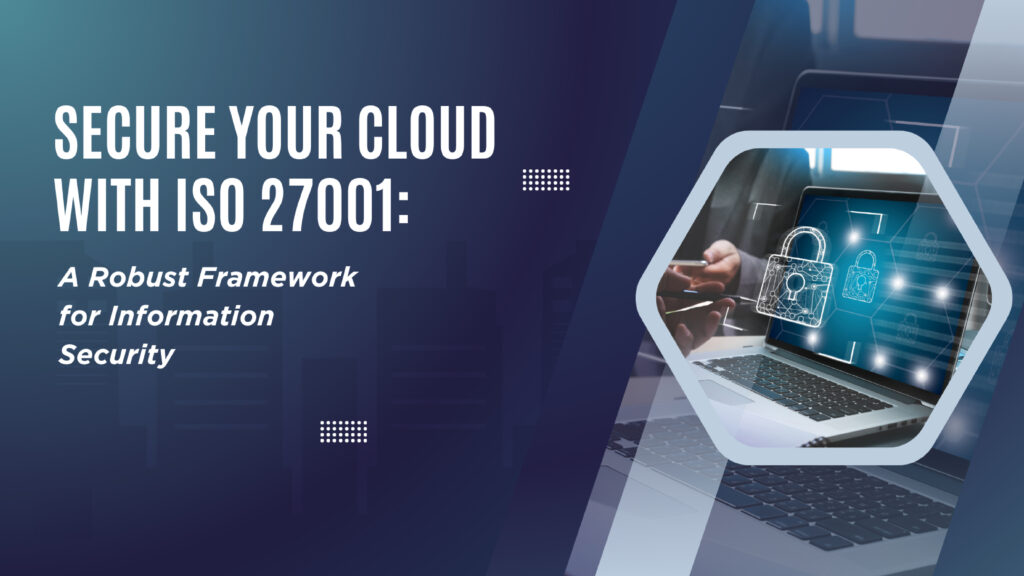
In today`s virtual age, companies are more and more shifting to the cloud for its scalability, cost-efficiency, and flexibility. However, this shift has additional specific risks to data protection, especially in terms of sensitive data saved or processed in cloud security. The ISO 27001 certification offers a robust, internationally identified framework for handling those potential risks. It makes sure that businesses can hold the confidentiality, integrity, and availability of their records.
What is ISO 27001?
ISO 27001 is part of the wider ISO/IEC 27000 category of requirements, specializing in information security management systems (ISMS). It establishes regulations and controls to systematically direct a corporation`s sensitive statistics, ensuring it stays secure. This generally facilitates groups becoming aware of dangers and placing security features in place to control or mitigate them.
While to begin with designed for conventional IT environments, ISO 27001 is now extensively implemented in cloud infrastructures. Thus, it makes sure that organizations can leverage cloud offerings without compromising protection.
Key Benefits of ISO 27001 in Cloud Environments
- Systematic Risk Management: ISO 27001’s threat control technique is especially vital in cloud environments, wherein businesses frequently lack complete management over their infrastructure. The standard calls for businesses to conduct daily threat assessments, making sure they become aware of potential vulnerabilities and weaknesses withinside the cloud architecture. By doing so, companies can deal with those risks earlier than they cause protection incidents
- Compliance with Global Standards: Adopting ISO 27001 for cloud services guarantees compliance with worldwide protection standards. For companies working across borders, adhering to ISO 27001 approach meeting worldwide regulatory requirements. For instance information safety legal guidelines like GDPR and industry-precise requirements like PCI DSS (for fee statistics)
- Strengthened Trust with Customers and Partners: Achieving ISO 27001 certification demonstrates to customers, partners, and stakeholders that your company takes into account about protection. In the cloud, wherein information is often allotted throughout specific geographies, transparency and trust are essential. By following ISO 27001 controls, companies can guarantee customers that their information is safe and secure from data breaches, unauthorized access, and different protection threats
- Continuous Monitoring and Improvement: One of the central concepts of ISO 27001 is non-stop improvement. This is especially critical in cloud environments wherein configurations and deployments are continuously changing. Continuous tracking guarantees that any rising threats or vulnerabilities are quickly recognized and mitigated, stopping breaches and many other protection incidents
ISO 27001 Controls for Cloud Services
Implementing ISO 27001 in cloud environments calls for adherence to precise controls that deal with the specific nature of cloud computing. Some of the commonly applicable controls include:
- Access Control (A.9): Cloud environments often have multiple access points, making it vital to put in force strict access controls. ISO 27001 calls for companies to control access primarily based at the principle of least privilege. This way the most effective legal employees can get the right of entry to sensitive records, or even then, only as a great deal as vital to carry out their activity functions.
- Cryptography (A.10): Cryptographic controls make certain that sensitive records, particularly personally identifiable information (PII), is encrypted in transit and at rest. Encryption in the cloud prevents unauthorized access and protects records from being compromised. Even though an attacker gains access to the infrastructure.
- Physical Security (A.11): While cloud companies cope with maximum physical protection measures, organizations need to recognize how their cloud companies shield records centers. ISO 27001 guarantees that physical protection controls like surveillance, constrained access, and environmental safety measures are implemented on the cloud company`s facilities
- Supplier Relationships (A.15): With the increasing rise of multi-cloud and hybrid-cloud environments, organizations more and more rely upon third-party companies for offerings like storage, computing power, and software. ISO 27001 guarantees that companies examine the safety practices of those providers and control risks associated with third-party offerings
- Information Security for Use of Cloud Services (A.5.23): Annex A.5.23 was introduced to deal with precise dangers in the use of cloud services. It outlines the necessities for making sure that protection controls amplify past the inner surroundings to cover the complete cloud infrastructure. This control emphasizes the want for clear contractual agreements among cloud provider companies and their customers. Hence, making sure obligations for records protection are defined precisely.
Steps to Achieve ISO 27001 Certification for Cloud Services
- Identify Scope and Boundaries: When enforcing ISO 27001 for cloud services, companies should first outline the scope in their ISMS. This usually consists of figuring out which cloud structures and records might be covered. Hence, making sure the ISMS protects all vital assets.
- Conduct a Risk Assessment: Risk checks is a vital part of ISO 27001. For cloud environments, this consists of figuring out vulnerabilities in the infrastructure. Which consists of misconfigured settings or insufficient access controls. The evaluation additionally needs to account for risks posed through the cloud company itself.
- Implement Required Controls: Based at the risk evaluation, companies should enforce suitable protection controls. This regularly entails operating intently with the cloud provider company to make certain they are additionally imposing vital protection measures.
- Monitor and Review: Cloud environments are dynamic, so non-stop tracking is vital. ISO 27001 emphasizes ongoing auditing and evaluation to make sure that protection controls stay effective over time. For cloud offerings, this could contain normal audits of the company`s infrastructure in addition to core structures.
Conclusion
ISO 27001 provides a structured framework to secure cloud environments. It enables organizations to protect their information and maintain customer trust. By implementing ISO 27001, businesses can confidently use cloud services while ensuring compliance with global standards. Thus, it will help them manage risks effectively, and safeguard sensitive data against emerging threats. For companies looking to make the most of cloud services while maintaining robust security, ISO 27001 is an invaluable asset. For more information, visit our website for further details.
